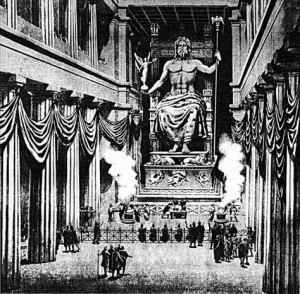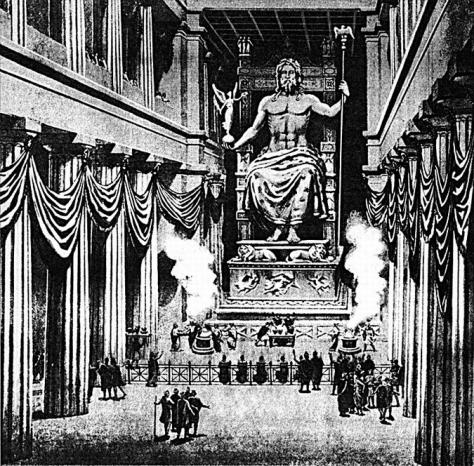
To understand how the ancient Greeks viewed their gods and goddesses, we first need to return to Plato’s conception of the universe. He was a philosopher of the metaphysical school, believing that the cosmos could be divided into an eternal realm of “being” which encompassed the intellect, the divine forms and ideas, as well as an ever-fluctuating, temporal and chaotic world of “becoming”. Everything that existed on the material plane or in the world of “becoming” was merely a debased and imperfect copy of its prototype, its first pattern and its ideal which existed in a permanently flawless and suspended state of animation within the eternal world of “being”. The metaphysical school of thought in Greece (i.e. long line of Hellenic mystics and philosophers including Pythagoras, Democritus, Plato, Bolus of Mendes etc. who formulated many of their doctrines after visiting Egypt) recognised these behavioural patterns and psychic imprints as “archetypes”.
The word “archetype” is Greek, coming from the syncretisation of the words arche, or first, and “typos”, denoting pattern. Thus the ancients were well aware of primordial and universal images which seeped through from the world of being and manifested in the world of matter. Philo Judaeus alluded to the archetype when he spoke of Imago Dei (God-image) in man and Irenaeus conformed to this idea by purporting that “The creator of the world did not fashion these things directly from himself, but copied them from archetypes outside himself”.
When psychiatrist Carl Gustov Jung came along in the twentieth century, he took the concept which encompassed the Platonic forms and ideals and applied it to the anatomy of the human psyche. He was certain that the primordial and unconscious blueprints which existed in the world of “being” were all plates which united to form the dynamic, multifaceted and multidimensional sphere of human personality. It’s more than fair to say that the concept of psychological archetypes was developed by Jung.
Plato placed the “archetypes” in the world of “being”; Jung on the other hand localised them to a level of being that related exclusively to the basement level of the mind’s triple-storey warehouse. He called this level the collective unconscious, a kind of memetic bank, a cosmic memory of sorts which encompassed energy fields like feelings, attitudes and discarnate personalities that lived inside each and every one of us for the entire duration of our lives, and which had lived inside every human being from our coming to consciousness. You might want to think of the collective unconscious as an intangible and psychic entity that acts quite like cellular DNA, transmitting the accumulating mass of psychic content from generation to generation across vast expanses of time in the manner that physical traits are passed from parents to children.
Among other things, “archetypes” are also part of this psychic river of transmission and coexist within all of us at an unconscious level. They usually surface during periods of unconsciousness, more often than not when we dream or daydream and they appear quite prominently in myths, fairy tales and all ancient religions as fully integrated functioning personalities. There are many, many, many archetypes. Some include love, the Sage, the Devil, the Hero, the Child, the Great Mother, Father Time and the Trickster. Even “the odyssey”, an idea which encompasses the ultimate life-altering journey (which also appears in myth) made famous by mythographer Joseph Campbell in The Hero with a Thousand Faces, is as archetype. So are Atlantis and Armageddon. The human soul is also an archetype, manifesting as the opposite sex of the dreamer in his or her sleep. In men it’s called the anima and in women the animus.
The ancient Greeks saw their gods and goddesses in much the same way, but unlike Jung (who believed the forces came from within) their perceived these forces as powers that existed independent of the human psyche. The Greek gods and goddesses belonged to an ethereal realm. They were omniscient, universal and timeless; they could never be touched by the ravages of time or any other limitations of mortality. Yet they interacted with mortals and even manifested through them. A temple maiden who’d suddenly felt the urge to kiss a man might have been described as a slave to Aphrodite. On the other hand, a man wanting to kill his wife for having slept with another man could be described as being overwhelmed by Ares, the god of war. Alternatively, a child overwhelmed by fits of laughter and merriment would have been perceived as having become the mortal vessel of Apollo, albeit fleetingly.
Back then, the cosmos was also perceived to be a an interdimensional hologram of intermingling and interconnecting wholes in which there was a powerful connection between differing conscious and unconscious extensions of nature. Thus, each god or goddess was connected with a specific metal, planet, colour, flower(s), animal(s), number(s) and perfume(s), and any contact, manipulation or acquisition of such would evoke the essence of that particular deity. For example, Aphrodite the goddess of love, was inexplicably linked with the colour green, the number seven, the metal copper, the precious stones of emerald and turquoise, flowering plants like myrtles, birds like doves, sandalwood, and the symbols of the five-pointed star, the apple, the tree, and the serpent (the occult significance and connection of these will be discussed in a later blog).
What can these aspects of nature have in common? Well Aphrodite is love, and love breeds generation; generation and fertility in Mother Nature appear decked in green. Copper, in turn, has a very aesthetic feel to it and turns green when it undergoes oxidisation or verdigris. In addition, copper salts are coloured green or blue and are connected with water, the element in which Aphrodite was born. The dove is her bird because it manifests a more tranquil mode of being, sandalwood her scent because of its erotic and sensual odour. Seven is a number related to various cycles and periods of humanity’s development, as well as the seven obscure points of the body. All these things are connected to her realm; the realm of matter and generation. You might say that these material representatives served as talismans to evoke the essence of the deity. This idea of cosmic sympathies between different elements in the physical world pervaded most philosophical beliefs of late antiquity and forms a central tenet in Hermetic Art and magical correspondences. Unhappily so, occult ideas about the cosmos ring true to select individuals able to think with an open mind and have been rejected, time and time again, sidelined and forgotten by an orthodox science which has become increasingly dogmatic in its ways, particularly after the Middle Age marriage of Aristotelian Scholasticism to Christian doctrine.
In any case, the fields of energy represented by the pantheon of Greek gods cannot be contained. If they are we become ill or unwell. This is why people who freely express themselves or allow themselves to be freely possessed by select archetypes working through them at any particular moment or time end up living far happier, healthier and longer lives than those who consciously choose to repress them. Psychic contents which are kept from seeing the light of consciousness because of prevailing social or moral limitations of the times will slowly but surely tear the human psyche apart, sometimes culminating with the onset of schizophrenia or split personality. Extreme cases include poltergeist activity caused by the unconscious will of sexually repressed teenagers. Let’s not forget the explosion of visions and folktales relating to nymphs, mermaids and other vampiric entities in Europe when emerged as an unconscious reaction to Christian dogma when the church fathers attempted to subdue sexuality, the side of human nature that was henceforth perceived to be sinful and shameful.
The ancient Greeks well and truly understood the consequences of such, which is why they prescribed sleeping in the encoemeterions of healing centres like Epidaurus and Amphiareion in Attica to those riddled by ailments. They were merely attempting to facilitate the expression of these energy fields in hope that the god or “archetype” would appear in the dreams of the ill-fated and bequeath a cure. Believe it or not this practice continues in Greece to this very day, particularly at the Church of Panagia Tinou on Tinos Island where innumerable people suffering from life-threatening or terminal illnesses come on the 15th August to seek a miracle cure in ekoimisis.
I will conclude this post with a poem I have written, an ode to the goddess Aphrodite:
As the morning star she rises
to the sky like an urgent kite
dressed in the lapis lazuli
of Milonian Aphrodite.
With Aurora’s blessing magical arrows
are shot from a winged car,
embedding themselves in the hearts of men,
level-headed or bizarre.
The outcome of her favourite pastimes
became gossip of historical lore,
unrelenting persuasions of surrender to love
internal battles for both virgin and whore.
At noon, trails of light blind
the wits of the wise.
Trapped willingly or by force
the laughter-lover takes no compromise.
Her conspirators –myrtle, dove and swan –
help rule over sea and skies,
then draw the claws of spite upon those
who’ve told too many lies.
Having woken lusts and passions
that shook many a foundation to the core,
At dusk they implore you, golden, fairest,
liberation from Love’s disease and war.









